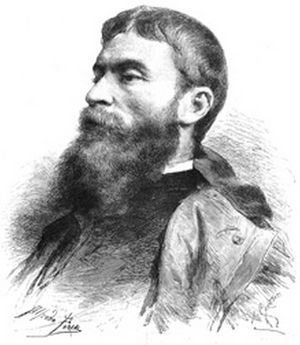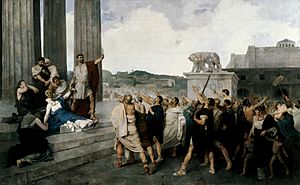Casto Plasencia facts for kids
Quick facts for kids
Casto Plasencia
|
|
|---|---|

Engraving by Alfredo Perea, 1886
|
|
| Born |
Casto Plasencia y Maestro'
17 July 1846 Cañizar, Spain
|
| Died | 18 May 1890 Madrid, Spain
|
| Education | Real Academia de Bellas Artes de San Fernando, Madrid; Academia Española de Bellas Artes, Rome |
Casto Plasencia y Maestro (born July 17, 1846 – died May 18, 1890) was a talented Spanish painter. He was known for his beautiful paintings of landscapes, portraits, and large wall murals.
Contents
Casto Plasencia's Life Story
Casto Plasencia was born in a town called Cañizar in Spain. Sadly, he lost both his parents when he was still a teenager. This meant he had to find a way to support himself and follow his dreams.
Luckily, some kind local nobles helped him out. They sponsored him so he could travel to Madrid. There, he joined the Real Academia de Bellas Artes de San Fernando, a famous art school. He was one of the first students to get a special scholarship to study at the new "Academia Española de Bellas Artes de Roma" in Rome, Italy.
Early Success as an Artist
Casto Plasencia became well-known in 1878. This was thanks to his painting called "Origin of the Roman Republic." This amazing artwork won first prize at the Exposición Nacional de Bellas Artes in Spain. It also earned a third prize at the big Exposition Universelle (World's Fair) in Paris, France.
Important Projects and Royal Portraits
After becoming famous, Casto Plasencia settled in Madrid. He was chosen to paint portraits of important people. These included King Alfonso XII and Queen María of Spain.
He was also very good at painting religious scenes. He helped decorate the huge San Francisco el Grande Basilica. He worked on the main dome, called a cupola. He also painted for the chapel of the Order of Carlos III.
Plasencia also helped decorate the beautiful Palacio del Marqués de Linares. He was one of the artists who started the Círculo de Bellas Artes, which is an important art club.
Painting Outdoors and Later Life
In 1884, another painter, Tomás García Sampedro, invited Casto to visit Muros del Nalón in Asturias. Casto loved the area's natural beauty. He started visiting every summer with other artists and students. They formed a group called the "Colonia artística de Muros." This group loved to paint outdoors, directly from nature, a style known as plein-air painting.
Sadly, Casto Plasencia passed away suddenly in Madrid. He was only forty-three years old when he died.
See also
 In Spanish: Casto Plasencia para niños
In Spanish: Casto Plasencia para niños


